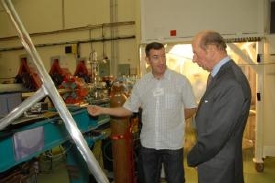Dec 17 2008
UK scientists have successfully demonstrated energy recovery on the ALICE advanced particle accelerator design, potentially paving the way for new accelerators using a fraction of the energy required under conventional methods.
 HRH The Duke of Kent visits ALICE at STFC Daresbury Laboratory. (Credit: Image courtesy of Science and Technology Facilities Council)
HRH The Duke of Kent visits ALICE at STFC Daresbury Laboratory. (Credit: Image courtesy of Science and Technology Facilities Council)
At 2am on 13 December, ALICE’s superconducting linear accelerator accelerated electrons to 99.9% of the speed of light, creating a beam with a total energy of 11 million electron volts. This was the first time the ALICE beam had been successfully transported around the entire circuit.
ALICE is operated by the Science and Technology Facilities Council (STFC) at its Daresbury Laboratory in Cheshire. It is a world-class R&D prototype designed to open the way for advances in a broad range of exciting accelerator science applications.
ALICE is the first accelerator in Europe to use the energy recovery process which captures and re-uses the initial beam energy after each circuit. At the end of the circuit, rather than throwing out the used beam of high-energy electrons, its energy is extracted for continued use before being safely discarded at an extremely low energy.
Susan Smith, Head of the Accelerator Physics Group at STFC Daresbury Laboratory said: “Energy recovery means a massive saving of power or alternatively, for the same power usage, light sources and colliders of unprecedented power and intensity. The ALICE team have been working tremendously hard to demonstrate energy recovery and when we did this in the small hours of Saturday morning, it felt like Christmas had come early.”
Dr Smith said the milestone was important but more work was required to fully validate the design.
“We have proven energy recovery, but not yet quantified it. Once fully commissioned ALICE will accelerate to 35 million volts, electrons will be sent round the accelerator at 99.99% of the speed of light and 99.9% of the power at the final accelerator stage will be recovered, making the power sources for the acceleration drastically smaller and cheaper and therefore economically viable,” she said.
Professor Keith Mason, Chief Executive of STFC, said: “This is an impressive and significant step forward for ALICE. In itself, the concept of energy recovery is not new, but the application of this technique in combination with advanced accelerator technologies, such as super-conducting cavities, has exciting prospects for the future of next generation light sources and particle colliders.”